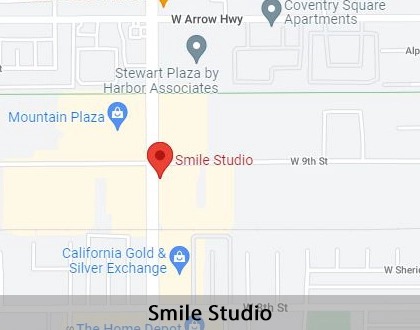Periodontics Upland, CA
Periodontics refers to a dental field that focuses primarily on diseases and conditions affecting the gums and supporting tooth structures. Periodontists provide services in diagnosing, preventing, and treating patients with periodontal, gum, and other oral diseases. Periodontal treatment can greatly improve symptoms, reduce pain, and prevent further dental complications from arising.
Periodontal treatment is available at Smile Studio in Upland and the surrounding area. We can help curb symptoms and keep oral diseases under control. Call us today at (909) 981-6400 to schedule an appointment or learn more about our services.
Signs Indicating Need for Periodontal Treatment
The most common cause of periodontal and gum disease is plaque buildup, often the result of poor oral hygiene habits such as inadequate brushing, flossing, and rinsing. Plaque eventually leads to tartar, a substance that eats away enamel and causes inflammation and infection. Tartar can also reach below the gum line, making the teeth harder to clean and maintain.
Other common risk factors include diabetes, hormonal changes in girls and women, medications that decrease saliva flow, certain illnesses, and genetics. According to the CDC, signs or symptoms related to periodontal disease include:
- Bad breath or bad taste that will not go away
- Red or swollen gums
- Tender or bleeding gums
- Painful chewing
- Loose teeth
- Sensitive teeth
- Gums that have pulled away from your teeth
- Any change in the way your teeth fit together when you bite
- Any change in the fit of partial dentures
“The most common cause of periodontal and gum disease is plaque buildup, often the result of poor oral hygiene habits such as inadequate brushing, flossing, and rinsing.”
Hard Tissue/Osseous Procedures
An osseous procedure is a periodontal treatment that reduces or completely eliminates bacteria living in pockets underneath the gums. explains that during the procedure , a surgeon cuts back the patient’s gums, removes the bacteria, and repairs damaged bone. Hard tissue procedures primarily curb the progression of gum disease but can also involve treating the enamel, dentin, and cementum.
In both hard tissue and osseous procedures, the primary goal is to remove bacteria from the pockets to prevent the spread of infection and disease. With advancements in modern dental technology, these procedures can be done using a laser that burns bacteria without coming close to the nerves, roots, or bone. Once the gums are reattached and sewn, they naturally heal and cling onto the tooth, slightly tighter than they were before.

“In both hard tissue and osseous procedures, the primary goal is to remove bacteria from the pockets to prevent the spread of infection and disease.”
Detecting Periodontal Disease
Stages of Periodontal Disease
“Dentists can identify and diagnose periodontal disease by checking for gum bleeding, swelling, firmness, and pocket depth.”
Preventing Periodontal Disease
- Brush your teeth: Brushing after meals can help remove food debris and plaque trapped between the teeth and gums; especially if one thoroughly brushes the tongue.
- Floss: Flossing at least once a day can help remove food particles and plaque between teeth and along the gum line that your toothbrush cannot quite reach.
- Swish with mouthwash: Using a mouthwash helps reduce plaque and can remove remaining food particles that brushing and flossing missed.
- Know your risk: Age, smoking, diet, and genetics can all increase the risk for periodontal disease. If at increased risk, be sure to talk with the dental professional.
- See a periodontist: Get an annual comprehensive periodontal evaluation (CPE) from a dental professional. A CPE looks at the teeth, plaque level, gums, bite, bone structure, and other risk factors for periodontal disease. Identifying symptoms of gum disease early is key to protecting the teeth and gums.
“First and foremost, practicing adequate oral hygiene habits is essential for proper oral care and function.”
Periodontal Surgery
“Surgical procedures include flap surgery, bone grafting, guided tissue regeneration, or soft tissue grafts.”
Questions Answered on This Page
People Also Ask
Q. What are the most common symptoms of periodontic diseases?
A. In the beginning stages, patients commonly experience swollen, bleeding gums, bad breath, and increased tooth sensitivity. In later stages, they may begin to notice loose or shifting teeth, and eventually, bone and tooth loss. It is important to seek a periodontist when first noticing early symptoms.
Q. What genetic factors or conditions influence gum and periodontal disease?
A. Although gum and periodontal disease are often the result of inadequate brushing and flossing, many genetic and environmental factors can also cause disease. Periodontitis and periodontal disease have been linked to systemic illnesses, including stroke, heart disease, diabetes, and certain types of cancer. A periodontist can help you understand your risk factors.
Q. How is periodontal disease treated?
A. Periodontal disease can be treated in a variety of ways depending on the patient’s case of level of severity. Non-surgical methods, such as scaling and planing or antibiotic therapy, can be done if the infection is caught in its early stages. In gum disease and periodontitis, periodontal surgery is often required to effectively remove the infection.
Q. What other treatments can a periodontist perform?
A. Periodontists work primarily with the hard tissues of the mouth. They are also specially trained in oral surgical procedures, meaning they can perform tooth extractions, bone grafting, dental implant placement, and various cosmetic procedures.
Q. What can I expect during my periodontal consultation?
A. During the consultation appointment, periodontists often review the patient’s health history and referral form to better understand their case. They will conduct their own examination and assessment which involves looking for indications of jaw dysfunction, gum recession, loss of bone, and/or periodontal disease. Using a periodontal probe, they will measure the pocket depths between the gums and teeth to determine whether a patient has the disease and what stage they are currently in.
Quality Dental Services Can Transform Your Smile
Periodontic Terminology
Bacterial Plaque
Bacterial plaque is a sticky film consisting of bacteria that coats teeth and can lead to tooth decay without proper oral hygiene.
Calculus
Calculus, also known as tartar, refers to the hardened dental plaque that forms on teeth due to a lack of proper oral hygiene.
Dental Prophylaxis
A dental prophylaxis is a thorough cleaning procedure that helps to prevent periodontal disease, gingivitis and the spread of plaque on the teeth.
Inflammatory Disease
An inflammatory disease can result from oral inflammation and can lead to other disorders such as a heart attack, stroke, diabetes, kidney disease, sleep apnea and more.
Peri-Implantitis
Peri-Implantitis refers to the inflammation of the soft and hard gum tissue that surrounds a dental implant and can be a result of losing supporting bone.
Periodontal Ligament
A periodontal ligament is a tissue that connects the tooth to the bone and is destroyed by advanced periodontal disease.
Periodontitis
Periodontitis is a lethal gum infection that results from poor oral hygiene, damaging soft tissue and destroying the bones that support the teeth.
Regenerative Procedures
Regenerative procedures can include services such as bone grafting that replaces missing bone in the jaw with bone from the patient, a donor or a substitute material.
Root Surface Debridement
During a root scaling procedure to remove tartar from the surface of the teeth, a professional will also use root surface debridement to ensure the teeth are clean.
Alveolar Bone Loss
Alveolar bone loss occurs when the bone containing the tooth sockets in the mouth decreases due to infection or resorption.
Comprehensive Periodontal Evaluation
A comprehensive periodontal evaluation is an effective and professional method for examining a patient’s teeth, plaque, gums, bite, bone structure and any potential risk factors to one’s oral health.
Gingival Flap Surgery
Gingival flap surgery is a procedure in which the periodontist separates the gums from the teeth temporarily to reach the root of the tooth and nearby bone.
Necrotizing Periodontal Diseases
A necrotizing periodontal disease is a disease that involves the necrosis of gingival tissues and lesions forming in the mouth.
Periapical Abscess
A periapical abscess is an abscess that forms from inflammation containing pus in the tissue surrounding the tooth.
Periodontal Pockets
Periodontal pockets form when disease destroys surrounding bone and tissue, resulting in pockets that can create space for bacteria to live in.
Periodontium
The periodontium is the tissue that surrounds and supports the teeth, gums, periodontal ligament and bone.
Root Scaling and Planing
Root scaling and planing is a non-surgical procedure that involves removing plaque and calculus from the pockets around the root before smoothing the surfaces of the root to help everything heal.
Call Us Today
Periodontal treatments can help prevent, curb, or treat periodontal disease and help you maintain a healthy oral cavity. Call us today at 909-981-6400 to schedule an appointment or learn more about our services.
Helpful Related Links
- American Dental Association (ADA). Glossary of Dental Clinical Terms. 2022
- American Academy of Cosmetic Dentistry® (AACD). Home Page. 2022
About our business, license, and website security
- Smile Studio was established in 1993.
- We accept the following payment methods: American Express, Cash, Check, Discover, MasterCard, and Visa
- We serve patients from the following counties: San Bernardino County, Riverside County, and Los Angeles County
- CA (License #47551). View License Information and Specifics
- National Provider Identifier Database (1700901527). View NPI Registry Information



